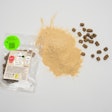
Despite careful ingredient screening for aflatoxin, low concentrations may get into your petfood undetected. A clay called HSCAS (Novasil) can provide you with better assurance of product safety.
Recent research at Texas A&M University has established better ways to inactivate aflatoxins. Earlier this year, dozens of dogs in the US died after eating aflatoxin-contaminated, commercial petfoods. The use of HSCAS could have prevented these deaths.
Heavy losses
Aflatoxin is a naturally occurring mycotoxin produced by two types of mold: Aspergillus flavus and Aspergillus parasiticus. Aspergillus flavus is widespread in nature and is most often found when certain grains are grown under stressful conditions such as drought.
Aflatoxins are potent liver toxins and carcinogens. Suppression of the immune system is also a common effect. Among the various mycotoxins, aflatoxins have been the subject of the most intensive research. The losses sustained from companion animal toxicity and death are incalculable.
Modern control measures
Aflatoxin control measures include using genetically engineered, resistant crops and ensuring appropriate storage conditions. These precautionary steps are followed by careful testing of susceptible commodities for aflatoxins and banning the lots that, in the US, exceed the regulatory action level of 20 parts per billion for aflatoxin B1. It is the most toxic type and is regarded as the "sentinel" substance for all other aflatoxins. HSCAS clay has lately been shown to be a good control measure.
Inactivation of aflatoxins
In a presentation at Petfood Forum 2006, Timothy Phillips, PhD, summarized research in his lab at Texas A&M University. It has focused on the development of innovative sorption strategies for the detoxification of aflatoxins. In particular, the lab has employed isothermal analyses and molecular modeling techniques to characterize and design clay-based materials for the enterosorption, and inactivation, of aflatoxins in the gastrointestinal tract.
Hydrated sodium calcium aluminosilicate (HSCAS) has been shown to prevent the adverse effects of aflatoxins in various animals when included in the diet. Studies have also confirmed that HSCAS can alter the bioavailability of aflatoxin in dogs (Bingham et al., Food Chem. Toxicol., 2004). Fortunately, HSCAS does not interfere with the utilization of vitamins and micronutrients in the diet. However, it is important to note that it does not protect animals against other mycotoxins.
Key criteria
Clay minerals are structurally and chemically diverse. Many are ineffective and/or nonselective for aflatoxins. Based on the Texas research, all aflatoxin sequestering agents should be rigorously evaluated in vitro and in vivo and should meet the following criteria:
Efficacy in multiple animal species;
Safety in long-term studies;
Negligible interactions with vitamins and micronutrients;
Favorable thermodynamic characteristics of ligand sorption; and
Tolerable levels of priority metals and dioxins/furans.
Research abstract
HSCAS is commonly used as an anti-caking agent in animal feeds. It tightly and selectively adsorbs aflatoxin. The following is an abstract from Bingham et al., Food Chem. Toxicol., 2004.
In a crossover study, six dogs were randomly fed a commercial dog food (no-clay control) or the same commercial dog food coated with HSCAS (0.5% by weight). These dogs were administered a subclinical dose of aflatoxin B1. Diets were switched and the process repeated. The HSCAS coated diet significantly reduced urinary aflatoxin M1 by 48.4%±16.6 SD versus the control diet.
The conclusion: HSCAS protects dogs fed diets with even minimal aflatoxin contamination. Despite regular and careful ingredient screening for aflatoxin, low concentrations may reach the final product undetected. Therefore, HSCAS may provide the petfood industry further assurance of canine diet safety.
Customized insurance
Aflatoxin management systems ultimately function like an insurance policy. Not every facility requires the same insurance plan. It is important to tailor a mycotoxin management program to fit the needs of individual facilities.















